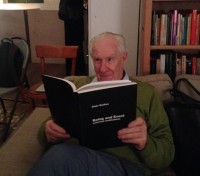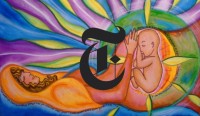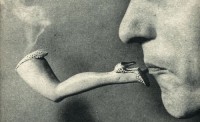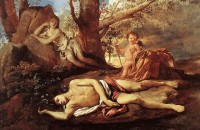a/cephalic discontents: an event series curated by das unbehagen
“A dictionary begins when it no longer gives the meaning of words, but their tasks. Thus formless is not only an adjective having a given meaning, but a term that serves to bring things down in the world, generally requiring that each thing have its form. What it designates has no rights in any sense and gets itself squashed everywhere, like a spider or an earthworm. In fact, for academic men to be happy, the universe would have to take shape. All of philosophy has no other goal: it is a matter of giving a frock coat to what is, a mathematical frock coat. On the other hand, affirming that the universe resembles nothing and is only formless amounts to saying that the universe is something like a spider or spit.” – Georges Bataille, Formless Click here to view the details f...Read More
Double Entendre: Katy Bohinc, Rachael Wilson & Jamieson Webster respond to Alain Badiou
Wendy’s Subway presented performances and discussion of Bohinc’s “psycho-sexual thriller” Dear Alain, Webster’s The Life and Death of Psychoanalysis (Karnac Books, 2011), which addresses Badiou’s theory of love and asks how it may be conceived from the psychoanalyst’s discourse; and Wilson’s “Fifteen Theses,” on her artist’s book created from Badiou’s Being and Event to investigate the rhythms of reading, pleasure in distraction, and the book as a “cover.” Badiou attended performatively, as an audience member. Click here to listen to Jamieson Webster at Wendy’s Subway Click here to listen to Rachel Wilson and Katy Bohinc at Wendy’s Subway Post-show discussion: Cecilia Wu responds to Jamieson Webster’s “Alain Badiou is Not a Walk in the Park”: Jami...Read More
Muriel Dimen: A Last-Minute Breakthrough – New York Times Couch
“Julia returned after the August vacation that we New York psychoanalysts customarily take. Well, not right after. She missed the first session. A family obligation, she said. Were I a traditional analyst, I might have wondered to myself: “Is there ambivalence here? Perhaps she doesn’t want to come back?” But I didn’t think that, or rather I ignored that flicker of doubt. I should have trusted my suspicions. When she did show up, Julia told me that she wanted to end the therapy. Very forthrightly, too. Cordially. She asked me about my summer and then said that this session would be her last.” Click here to read more
Josh Cohen: Art, Psychoanalysis, Art and the Logic of Indifference
“As Leo Bersani and others have observed, there is a paradox at the heart of the Freudian corpus that animates and finally undoes it. In resisting the theoretical innovation of the death drive, Freud’s contemporaries were resisting an inner tendency of psychoanalysis to corrode the capacity of any stable concept to contain and master the forces it discloses. It’s with a certain poignancy of understatement that Freud describes the existence of masochism, in his 1925 essay on the subject, as a ‘problem’ from an economic point of view. ‘Eco – nomos’, the law of the home, the even flow and distribution of energy, is ruined at a stroke by masochism, the psycho-sexual preference for pain over pleasure, for the heightened agitation rather than contented homeostasis of the organism. But as J...Read More
Orna Shachar: The Therapeutic Gaze – New York Times Couch
“Daniel, a handsome 50-year-old whom I name the Marlboro Man because of his hyper-masculine looks and swagger, walks into my office and drops his body on the couch across from me. In a monotonous voice, his speech laced with obscenities, he announces his failure — his failure in life, in relationships with women, at work. He sits with his legs wide apart, as if penetrable, open and passive. Yet this posture also somehow feels invasive, penetrating and even threatening to me.” Click here to read more
Evan Malater & Cecilia Wu: Pass the Porcupine – Freud, Porcupines and You
dear Porcupines, As an extra credit assignment following the Angelo Villa talk, Cecilia Wu and I became interested in the porcupine parable from Schopenhaeur that Angelo Villa offered towards the end of his presentation. Angelo used the parable to address the question of how a group might survive its narcissistic and hysteric tendencies, its craving for leadership and its hatred of leaders, its belief in democracy in the face of the reality of inequality and its tendency to propagate itself on fumes of unanalyzed transference to mischievous effect. We became curious about the porcupine parable. A random google using keywords “Freud porcupine” revealed a whole teeming history of Freud andporcupines that amazed us and led us to weeks of porcupine research that we now share with...Read More
Esther Sperber: The Architecture of Psychotherapy – New York Times Couch
“If you listen to psychotherapists when they talk to one another, you will often hear them speak of something called the “therapeutic frame.” This term, coined by the psychoanalyst Marion Milner, refers to the set of conventions and ground rules that structure the therapeutic experience. Just as the frame of a painting defines the borders of a work of art, the therapeutic frame is the “container” in which the therapy takes place. Architecture is a meditation on entering and exiting.” Click here to read more
Vanessa Sinclair: Das Unbehagen of Duchamp, Dada and Psychoanalysis
“In 1917, Marcel Duchamp submitted a urinal to the first annual exhibition of the Society of Independent Artists here in New York under the pseudonym, R. Mutt. Duchamp was one of the founding members of this organization, along with Walter Arensberg, Katherine Dreier, Man Ray, and Joseph Stella. This society was founded with the intention of providing a platform for individual artists to showcase their work, whether new, experienced, experimental, or avant-garde, and was dedicated to advancing the ideas of independent artists, free of juries, prizes, or ranking of any kind. As long as one paid the entry fee of six dollars, one’s work would be shown. The first annual exhibition included over 2,000 works of art. The catalog was organized and the exhibition hung in alphabetical order by...Read More
Adele Tutter: Under the Mirror of the Sleeping Water – Poussin’s Narcissus
Nicholas Poussin’s four paintings on the theme of Narcissus and Echo, completed over the course of three decades, reflect a deepening appreciation of their source in Ovid’s Metamorphoses. Poussin’s interpretations of the Narcissus myth parallel critical junctures in the development of psychoanalytic theories of narcissism, including those of Freud, Andreas-Salome, and Rosenfeld. The analysis of Poussin’s evolving vision supports a radical reappraisal of the enigmatic myth at the heart of psychoanalytic theory and practices, and the disturbances named after it. Click here to listen to audio Click here to read Adele Tutter’s “Under the mirror of the sleeping water: Poussin’s Narcissus” published in the International Journal of Psychoanalysis, 2014 Cecilia Wu’s C...Read More
Matthew Oyer: Hysteria and the Psychoanalytic Act
“The history of hysteria spans nearly four thousand years: four thousand years of the wilderness of women’s bodies and of manifest destiny, or the attempts of men to push ever further the boundaries of the frontier, four thousand years of shame, of defiance, four thousand years of theater, of desire’s sting and the “infection of the Idea” (Badiou, 2013). Hysteria, from the Greek hystérā, womb, hysterikós, of the womb. The womb that wanders. As the father of Western thought, Plato, described, “The uterus was rebellious and masterful, like an animal disobedient to reason, and maddened with the sting of lust” (Plato, 1963/1973, p. 1210). Desiring, violent, creaturely stuff. Throughout these four thousand years, the myriad ways hysteria has been conceptualized, and all of its rapidly flu...Read More
Claude-Noële Pickmann: Suppléance by the Symptom: A Case of Anorexia
“The feminine Oedipal structure as Freud discerned it in his young hysteric patients in the first half of the twentieth century has taught us that the question “what is a woman?” is first posed by a girl to her mother. Later, upon finding that the maternal response has only misled her, she chooses to pose the question to her father, as if, in the course of her searching, she had the presentiment that an appeal to the father’s desire was likelier to enlighten her as to what awaits her as a woman than the connection she maintains with her mother, privileged as this is. Whether Dora or the case of the young female homosexual, these patients showed Freud—well before he was able to properly gauge the measure of the problematic—that an Oedipal girl chooses to avail herself of the father, ...Read More
Jamieson Webster: The Accidents of Psychoanalysis – New York Times Couch
“In the aftermath of what we shrinks call “August” — a euphemism for the acute clinical moments that our patients experience while we’re away for the standard three to five weeks of vacation — I found myself reflecting on a series of physical accidents that befell too many of my patients during my break not to note. If two patients fall down stairs, another is involved in a pedestrian accident, one more falls off her bike and yet another suffers severe burns, what am I to make of this? Was it coincidence? Or were their mishaps somehow a continuation of their work with me in analysis?” Click here to read more























